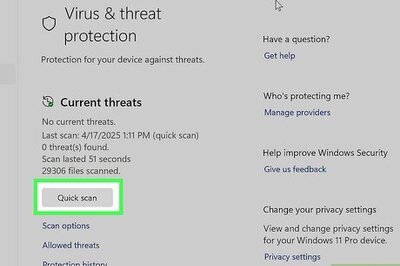
views
Guwahati: Ahead of the Lok Sabha elections, general secretary of the pro-talks faction of United Liberation Front of Assam (ULFA), Anup Chetia, visited the disputed border village of Langpih and appealed for peace.
Chetia organised a meeting along the Assam-Meghalaya border on behalf of the North East Indigenous People’s Forum (NEIPF) wherein villagers from both the states promised to maintain law and order in the region.
“There should be a spirit of brotherhood among us. It is the task of the two (Assam and Meghalaya) governments to resolve all the inter-state problems,” said Chetia.
On behalf of the forum, other than Anup Chetia, there were members representing the two states. There were also representatives of the Hynniewtrep National Youth Front, Ri Bhoi Youth Front and Federation of Khasi Jaintia and Garo People who took part in the border meeting.
Langpih, (also spelt as Langpi) is located along the West Khasi Hills district of Meghalaya and Kamrup district of Assam.
The village has been a subject of a long-standing dispute between the two states, one of the 12 such territories along the border.
Every year, a calls for resolution are raised by those living along the fringes and talks are held even as the state governments continue to blame each other for the delay in arriving at a long-lasting solution.
“Langpih is one of the most beautiful areas in the northeast. Governments should promote the site for tourism. We appeal to both the governments to do so as soon as possible for a better life for the local people ’, Chetia added.
In 1974, there was a face-off between government forces in the village after Meghalaya police personnel allegedly evicted Nepali grazers from the area leading to a probe by cops from Assam.
On May 14, 2010, clashes broke out between Nepali and tribal Khasi and Garo communities, leading to firing by police. Reports claimed four Khasi villagers died of gunshot wounds.
In 2012, Pynskhemlang Nongshlong, a resident of neighbouring Rambrai village, launched a hunger strike along with 13 others in the memory of the four slain men.
Two hours into the fast, the assistant district commissioner of Kamrup and 150 policemen from Assam reached the site.
However, Langpih villagers formed a human chain and denied any access to the police. By the eighth day, eight of the fasters had to be taken to Shillong Civil Hospital, while Nongshlong and five others started showing symptoms of dehydration.
As the fast neared its second week, the then Meghalaya chief minister, Mukul Sangma, appealed to New Delhi for assistance.
Nongshlong declared an end to the fast on 13 July and gave the administration a deadline of two months to fulfill a list of demands of the villagers.
However, on 16 July, Nongshlong and four women resumed their fast at Nongstoin. Around the same time, the Meghalaya People’s Human Rights Council sent a delegation to the 20th Session of the United Nations Human Rights Council in Geneva, Switzerland.
The council secretary, Dino Dympep, met the UN Special Rapporteur, James Anaya, and discussed the 2010 killings, following which Anaya sent a communique to the government of India. However, the government failed to respond to the communique even after a month.
In March 2011, the Meghalaya assembly passed a resolution urging the Centre to form a boundary commission to resolve the long-pending issues between the two states.
The Assam assembly too, passed a resolution, but against the setting up of such a commission.
Post this, the then Union home minister P Chidambaram held a meeting with the chief ministers of both the states and it was decided the states would hold chief secretary-level talks.
A major controversy had erupted when the Survey of India published maps without 153 villages along the Khasi Jaintia Hills in 2011
The agency, in its defence, had said the maps were prepared on the basis of the North-Eastern Areas (Reorganisation) Act, 1971.
(Photo: Anup Chetia along with the local people's at Langpih on Saturday)




















Comments
0 comment